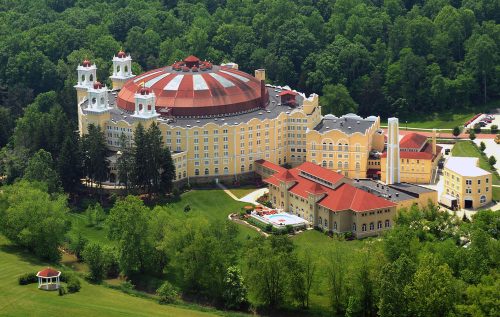BY ELIZABETH DUNLOP RICHTER
Jump into your time machine and set the dial for Chicago 1904. You’re feeling a bit rundown and have some aches and pains that need attention. You’ve heard about the 1903 renovation of the famed West Baden Springs Hotel completed just one year after a devastating fire and featuring the largest freestanding dome in the country. A mile away stands its rival, the French Lick Springs Hotel, both promising to cure what ails you.

West Baden Springs Hotel advertisement.
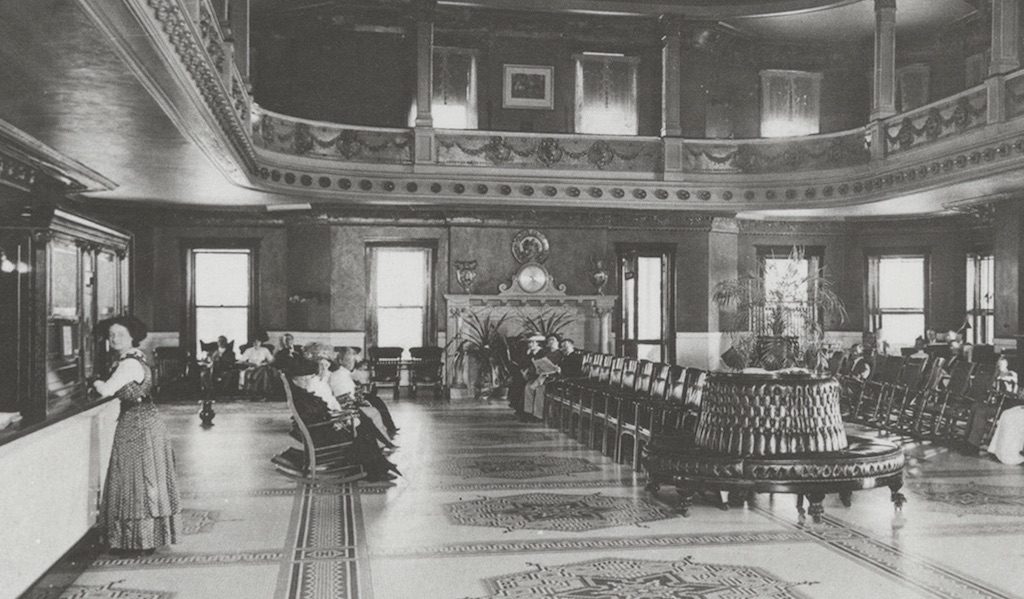
French Lick Springs Hotel.
Located in the Indiana town of French Lick, named for a French fort and a salt lick, the two hotels had been providing healing waters to visitors since 1845 (French Lick Springs Hotel) and 1850 (West Baden Springs Hotel). They were modeled after such famed European spas as Carlsbad and Wiesbaden. And all less than a day from Chicago by train in southern Indiana? Irresistible!
Thanks to railroad mogul George Pullman, it’s an easy journey. You and your family own one of his private rail cars that can be attached to a regular passenger train. Called “rolling mini mansions” by travel writer Robert Khederian, yours includes an observation deck, parlor, and staterooms with a dining room at the far end, complete with pantry and galley. And since the Monan Railroad built a spur to the resorts in 1887, your private car delivers you directly to the town of French Lick and the two hotels. As you disembark, you see other fashionably dressed guests leaving the train or stepping down from horse-drawn carriages.
You are awestruck by the stunning new atrium at West Baden Springs. Called by local press the “Eighth Wonder of the World,” the atrium has a massive dome 130 feet high, its floor 208 feet wide, surrounded by 24 columns supporting 24 4½-ton girders.
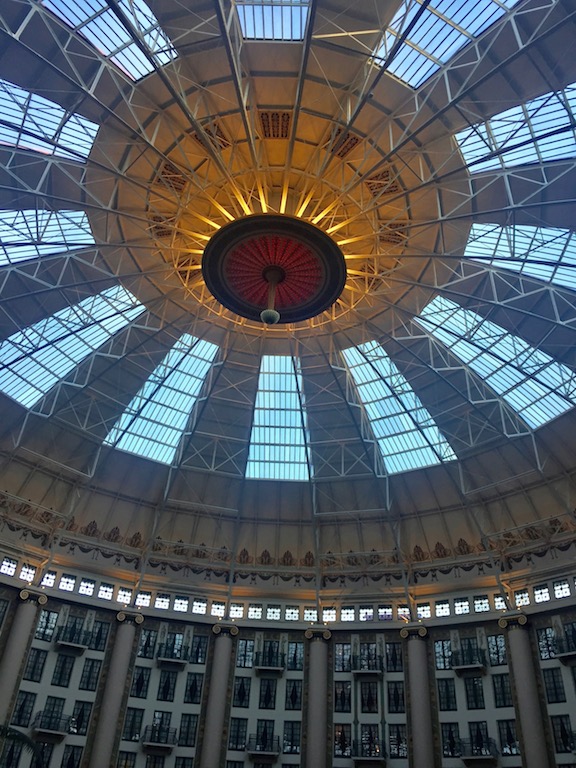
West Baden atrium dome.
You find not only luxurious surroundings but also the promise of cures for everything from jaundice and asthma to obesity and gout, thanks to the famous natural mineral springs tapped for bathing, soaking, or drinking when promoted as Pluto Water (French Lick Springs) or Sprudel Water (West Baden Springs).
Now, in 2019, one hundred and fifteen years later, we, like the putative 1904 visitor, had also read about an astonishing renovation of the West Baden Springs Hotel and French Lick Resort, this time in 2006. On a road trip to Charleston, South Carolina, we realized it was the perfect place to break up the drive. We arrived not in a private rail car but in our jaunty blue Subaru.
There are changes to be sure. The Monan Railroad doesn’t exist to deliver your private rail car, but your private plane can land at the nearby French Lick Airport, where you will be shuttled to either resort. The two resorts are no longer rivals; they are now jointly owned and were elevated to the National Register of Historic Places in 2003.
During the past 115 years, the resorts have had dramatic ups and downs. In the early 20th century, French Lick attracted a wide range of notable visitors, including Chicago mayor “Big Bill” Thompson, auto baron J.M. Studebaker, and such movie stars as Bob Hope, Bing Crosby, and Lana Turner. Owned from 1901 to 1929 by Tom Taggart, outgoing mayor of Indianapolis and national chair of the Democratic Party, and later by his son, French Lick Springs Hotel was a favorite of sports champions and politicians alike.
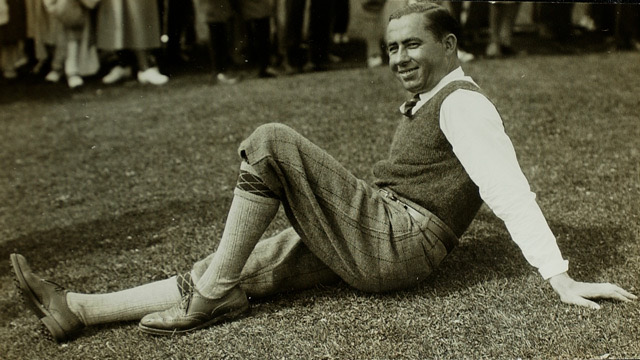
1924 PGA champion Walter Hagen.
The 1924 PGA championship, won by golfing great Walter Hagen, was held on French Lick’s Don Ross championship golf course. Major league baseball teams trained on the premises and sometimes actually held batting practice in the West Baden Springs atrium to entertain guests. The unofficial headquarters of the Democratic Party, the site was chosen for the 1931 governor’s conference where Franklin Delano Roosevelt gathered support for his nomination as president.
While French Lick Springs survived as a hotel through the Depression, West Baden Springs fell on hard times after the stock market crash of 1929. The hotel was sold to the Jesuits in 1932 and served as a seminary, West Baden College, until 1964 when a benefactor leased it to Northwood College. The property went through several additional owners and then sat empty, neglected and deteriorating for 13 years. Finally, Landmarks Indiana recognized its importance and stabilized the structure.
The most recent purchase and restoration of both properties were stimulated by a vigorous and ultimately successful campaign to convince the Indiana state legislature to grant a casino license. For decades, the resorts had attracted gamblers who frequented the many illegal casinos in the region. Police raids in 1949 finally shuttered the nearby Brown’s Hotel and gaming disappeared from the area.
In the late 20th century, Indiana licensed riverboat casinos and pressure built for land-based options. Among the interested 21st-century developers was Donald Trump, who had owned a riverboat casino in Gary, Indiana. Negotiations with Trump, deeply in debt for his Atlantic City casino, were terminated by the state in 2005. The properties were ultimately purchased by Indiana-based Cook Group, Inc., a medical device company. Owners Bill and Gayle Cook and their son Carl poured tens of millions of dollars into building a new casino and restoring both hotels to their former splendor, including a massive restoration of the West Baden Springs dome and turrets. The combined properties were jointly renamed as the French Lick Resort, with each hotel retaining its unique character.
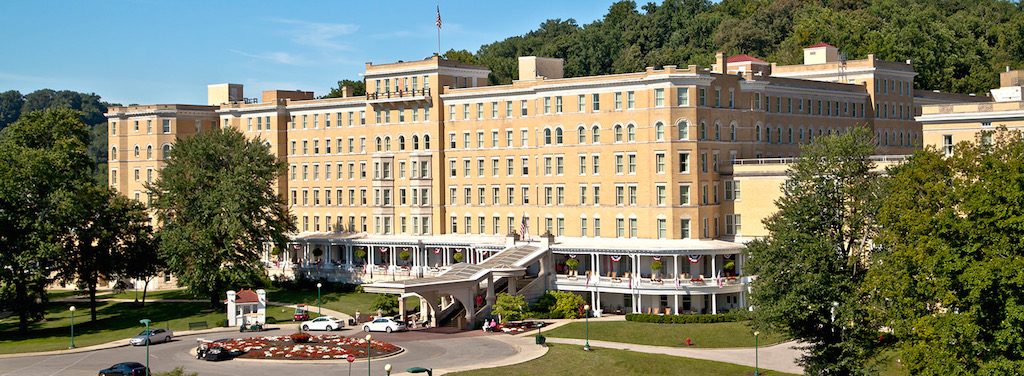
French Lick Springs Hotel. From the World Property Journal.
We chose to stay in the French Lick Springs Hotel. Walking into the beautifully restored lobby, we had our moderate expectations immediately exceeded. It was not hard to imagine elegantly dressed families stepping down from their private rail cars, followed by staff handling trunks filled with 1904 resort wear. Fashionable women would have walked across ornate floor mosaics reflecting the trendy art deco-inspired designs of the early 20th century.
The two-story lobby is lined with gilded ornamental moldings and broad arches that draw the eye up to elaborate ceiling murals of scenes inspired by antiquity. According to the New York Times, 6,000 square feet of gold leaf were used for the restoration.

French Lick lobby ceiling.
Massive carved stone fireplaces promise warmth on chilly nights. Discrete signage points to the spa, ballrooms, restaurants, and the casino. We quickly unpacked in our spacious accommodations and set out to see the other hotel, the West Baden Springs.
We could have walked the beautifully landscaped mile to the sister hotel but chose to take the historic trolley so we could enjoy as fully as possible the 1904 experience. The trolley had been installed in 1903 to enable guests to avoid dirt and horses for the short ride into town or to the West Baden Springs grounds. With the arrival of the automobile, the trolley was shut down in 1919. Enthusiasts at the Indiana Railway Museum located a Portuguese trolley car in 1987 that was similar to the original. Thanks to a $200,000 grant from the Indiana Department of Transportation, the car and track were restored. Trolley Car #313 efficiently carries guests from one hotel to the other. A charming uniformed conductor points out the historic details of the grounds, the car and its provenance.
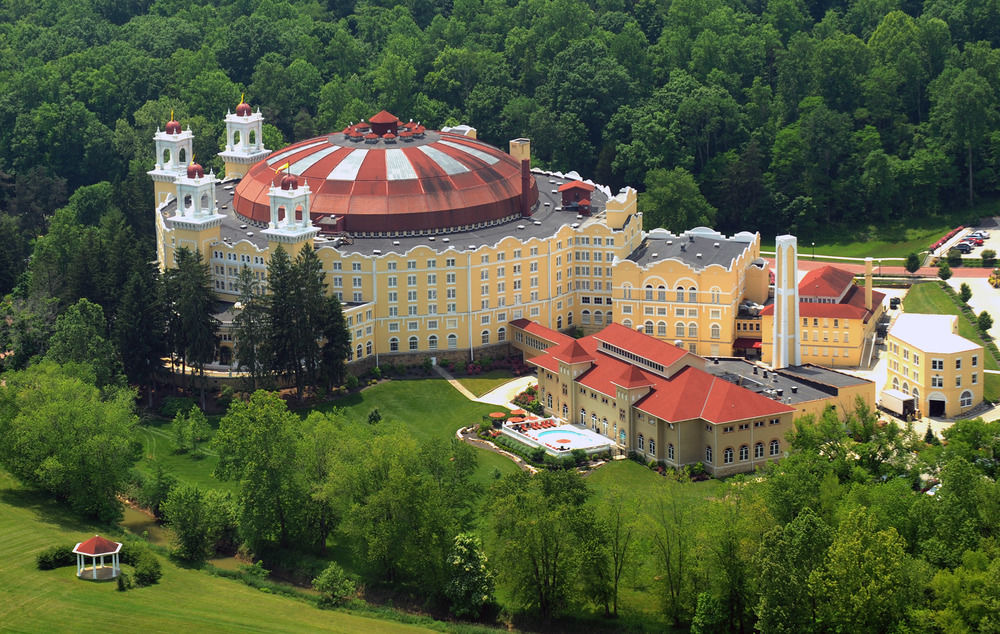
West Baden Springs Hotel. From the World Property Journal.
We found the lobby of the West Baden Springs Hotel just as handsome as that of French Lick Springs Hotel, here sporting a handsome dome. Close by are indoor and outdoor swimming pools, and more period decor. But these features are nothing compared to the featured attraction.
Even having seen photographs and read details of its restoration, we were still not prepared for the experience of entering the huge West Baden Springs Hotel atrium. One could easily imagine batting practice, circuses, and any number of other amusements staged here over the years.
We settled for a drink at Ballard’s, the bar neatly integrated into the atrium wall and then enjoyed a casual dinner in the adjacent corner of the immense dome. Several private groups had arranged for tables reserved in areas separated by potted plants.

West Baden atrium.
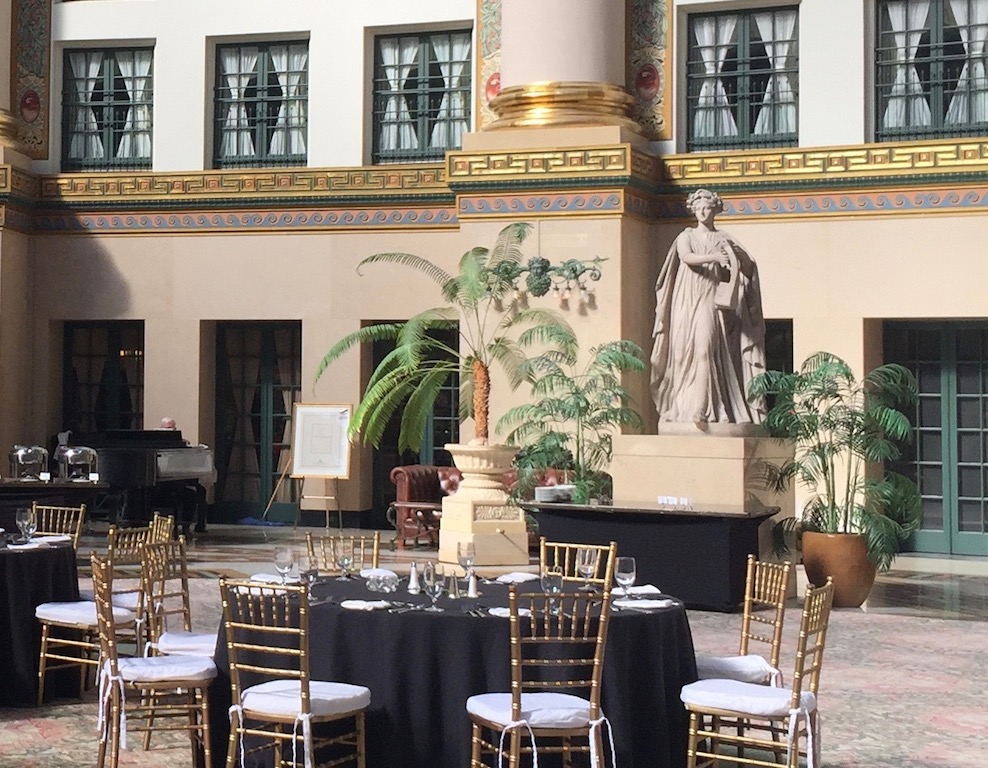
Dining in the atrium.
All the rooms of the hotel open onto the atrium. Elegant details define the divisions between floors and windows. Greco-Roman statuary enhances the ground level. Still, the expanse of the open area dwarfs the ornamentation. In 2011, Cincinnati’s CityBeat reporter Steven Rosen described the stunning Rookwood fireplace, a major feature of the atrium:
The fireplace’s pottery surface, which looks like it was assembled in chunks rather than smooth tiles, depicts an idyllic, colorfully glazed pastoral scene, lorded over by a red-costumed elf sitting on a rock amid cascading waters and holding up a ram’s horn. He is Sprudel, once the mascot for the hotel and under whose name its medicinal water was bottled and sold. Across from him is a catalpa tree, and in the distance under pod-carrying limbs is visible a small depiction of the hotel.

A West Baden dining area set in front of its famous Rookwood fireplace.
Ohio’s famous Rookwood Pottery was established 130 years ago in Cincinnati by artist Maria Longworth-Nichol and thrives today as one of the country’s premier sources of handmade ceramic pottery and architectural tile. You can find examples in the gift shop just off the atrium but no longer available is its once best-selling bottled Pluto Water. Both Pluto Water and Sprudel mineral water were once major attractions of the resorts. Pluto Water was marketed for its laxative qualities.
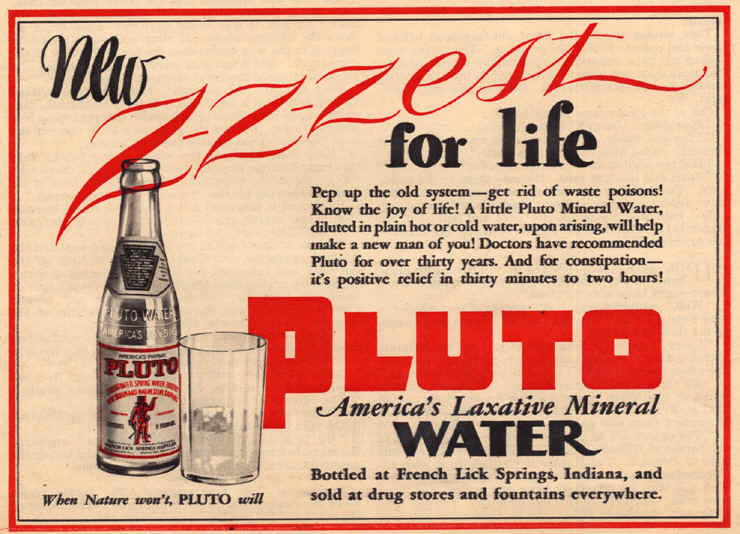
Pluto Water.
It’s been written that the mineral water was so effective that additional “rest facilities” were placed strategically around the grounds to accommodate those who drank it. The presence of lithium in the water ended its sale as a beverage when lithium was declared a controlled substance in 1971. (Lithium is an element used in both manufacturing processes and as a medical treatment for depression.) Sprudel Water was the same water, though marketed differently, primarily as a relaxing and beneficial soak. Today both resort spas feature baths in the natural mineral water.
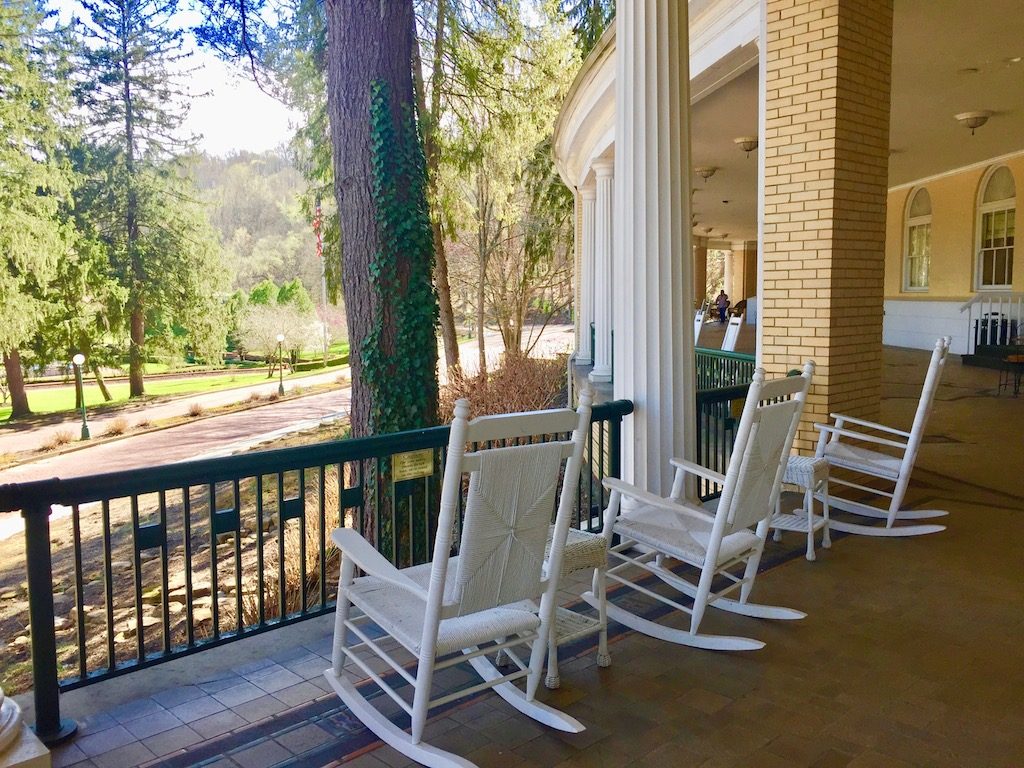
West Baden rocking chairs.
After a hearty breakfast back at French Lick of made-to-order omelets and fresh pastries, we reluctantly packed our bags to continue on to Charleston. Although we did not have time to explore all the offerings of the resort, we can report that the casino promises to fulfill any gambler’s fantasies, the golf options are of championship quality, the rocking chairs are enticing, and the myriad events and celebrations offer numerous reasons to visit. Definitely a road trip to consider!



